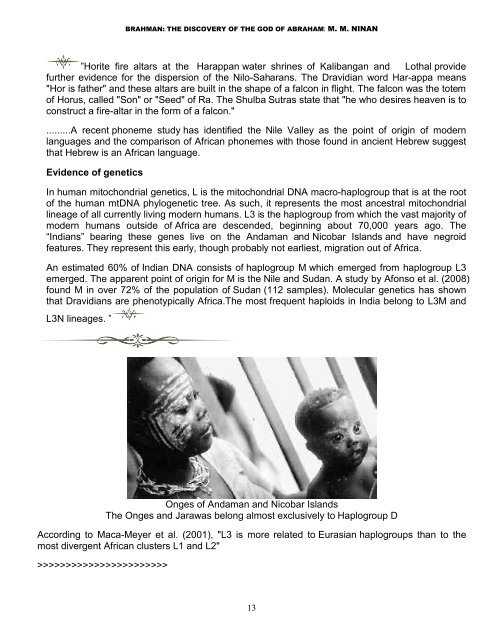You also want an ePaper? Increase the reach of your titles
YUMPU automatically turns print PDFs into web optimized ePapers that Google loves.
BRAHMAN: THE DISCOVERY OF THE GOD OF ABRAHAM: M. M. NINAN<br />
”Horite fire altars at the Harappan water shrines of Kalibangan and Lothal provide<br />
further evidence for the dispersion of the Nilo-Saharans. The Dravidian word Har-appa means<br />
"Hor is father" and these altars are built in the shape of a falcon in flight. The falcon was the totem<br />
of Horus, called "Son" or "Seed" of Ra. The Shulba Sutras state that "he who desires heaven is to<br />
construct a fire-altar in the form of a falcon."<br />
.........A recent phoneme study has identified the Nile Valley as the point of origin of modern<br />
languages and the comparison of African phonemes with those found in ancient Hebrew suggest<br />
that Hebrew is an African language.<br />
Evidence of genetics<br />
In human mitochondrial genetics, L is the mitochondrial DNA macro-haplogroup that is at the root<br />
of the human mtDNA phylogenetic tree. As such, it represents the most ancestral mitochondrial<br />
lineage of all currently living modern humans. L3 is the haplogroup from which the vast majority of<br />
modern humans outside of Africa are descended, beginning about 70,000 years ago. The<br />
“Indians” bearing these genes live on the Andaman and Nicobar Islands and have negroid<br />
features. They represent this early, though probably not earliest, migration out of Africa.<br />
An estimated 60% of Indian DNA consists of haplogroup M which emerged from haplogroup L3<br />
emerged. The apparent point of origin for M is the Nile and Sudan. A study by Afonso et al. (2008)<br />
found M in over 72% of the population of Sudan (112 samples). Molecular genetics has shown<br />
that Dravidians are phenotypically Africa.The most frequent haploids in India belong to L3M and<br />
L3N lineages. ”<br />
Onges of Andaman and Nicobar Islands<br />
The Onges and Jarawas belong almost exclusively to Haplogroup D<br />
According to Maca-Meyer et al. (2001), "L3 is more related to Eurasian haplogroups than to the<br />
most divergent African clusters L1 and L2"<br />
>>>>>>>>>>>>>>>>>>>>>>><br />
13


















